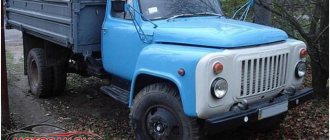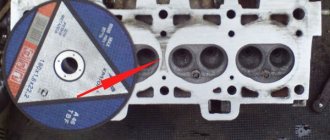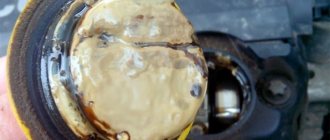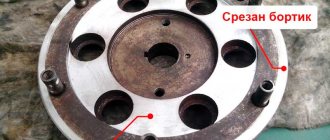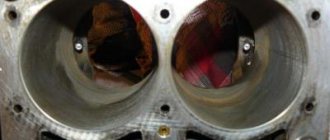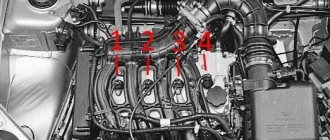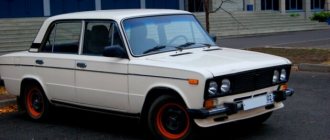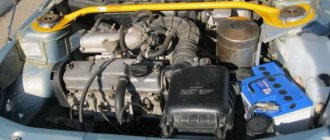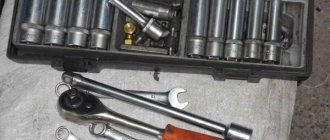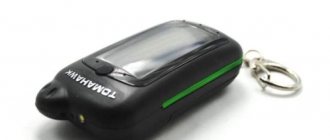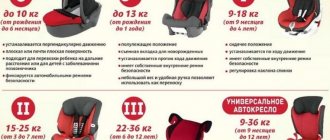Removal
1. Place the car on an inspection hole or overpass (see “Preparing the car for maintenance and repair”).
2. Remove the cylinder head from the engine (see “Cylinder head gasket - replacement”).
4. Unscrew the nuts of the connecting rod caps (without removing the crankshaft) and push the piston and connecting rod out of the cylinder block (see “Crankshaft - removal and installation”).
5. Remove the steel-aluminum liner from the connecting rod cover.
The connecting rod and cap are stamped with the number of the cylinder in which they are installed.
6. Place the connecting rod in a vice and remove two compression rings and one oil scraper ring with an expander from the piston.
7. Press the pin out of the connecting rod through the mandrel and remove the piston.
Similarly, remove the pistons of the remaining cylinders.
Before installing the piston group on the connecting rod, it is necessary to select its parts.
Operation of diesel and gasoline internal combustion engines
To better understand the importance of piston ring clearance in engine operation, let's consider how the two most common systems work. In reality, the difference between them is not that great, at least in terms of design.
The main difference is the ignition process. In diesel engines it occurs due to increased pressure. As a result, the temperature rises, after which the nozzle injects fuel inside, and ignition occurs on its own.
The gasoline engine is designed a little differently. Instead of an injector, spark plugs are installed at the top of the pistons, which supply sparks. Naturally, with such a design, normal piston ring clearance is very important.
This is interesting: How to disassemble a bicycle fork with a shock absorber
Selection of connecting rod and piston parts
1. Select the piston to the cylinder. The calculated gap between the cylinder and the engine piston should be 0.06-0.08 mm. It is determined by measuring the cylinders and pistons and is ensured by installing pistons of the same class as the cylinders. The maximum permissible gap is 0.15 mm. The piston diameter is measured in a plane perpendicular to the piston pin, at a distance of 52.4 mm from the piston bottom. The outer diameter of the pistons is made into five classes (A, B, C, D and E) every 0.01 mm, and the diameter of the piston pin hole is made into three categories every 0.004 mm. Spare parts include pistons of groups A, C and E. The piston class (letter) and the category of the piston pin hole (number) are stamped on the piston bottom.
For correct orientation of the piston relative to the cylinder, there is a “P” mark on the piston wall (next to the boss), which should be directed towards the front of the cylinder block.
We measure the cylinder diameter with a bore gauge in four zones, both in the longitudinal and transverse directions of the engine.
In belt zone 1, the cylinders practically do not wear out. Therefore, by the difference in measurements in the first and other belts, we judge the amount of cylinder wear.
Scheme for measuring cylinder diameters:
1, 2, 3 and 4 - belt numbers; A and B - measurement directions
The cylinders are divided into five classes by diameter every 0.01 mm: A, B, C, D and E. The cylinder class is stamped on the bottom plane of the block.
2. We select the finger to the piston. The pin is installed in the upper head of the connecting rod with tension and rotates freely in the cylinder bosses. According to the outer diameter, the fingers are divided into three categories every 0.004 mm. Categories are indicated by a colored mark on the end of the finger: blue - the first category, green - the second, red - the third. We check the mating of the piston pin and the piston by inserting the piston pin (lubricated with engine oil) into the holes of the piston bosses. The piston pin must be installed by simply pressing the thumb and not fall out when the pin is in a vertical position.
3. Check the gap between the grooves and piston rings. The gaps must correspond to the values given in table. 8.1.3 (see below). An increased gap leads to rapid wear (breaking) of the piston grooves.
Table 8.1.2. Dimensions of the main mating parts of the engine
Piston - cylinder (for VAZ-2103 engine)
Piston - cylinder (for VAZ-2106, VAZ-21011 engines)
2nd category (green mark)
3rd category (red mark)
Piston pin - upper end of connecting rod
Table 8.1.3. Gaps in the mating of grooves and piston rings
Upper compression ring - piston groove
Lower compression ring - piston groove
Oil scraper ring - piston groove
Table 8.1.4. Gaps in piston ring locks
Upper compression ring
Bottom compression ring
Six engine tuning methods
Forged pistons
The factory usually installs cast pistons. In order to reduce the load, you can use forged ones instead. They have less weight. Moreover, at high speed, casting begins to work less efficiently than forged metal.
You can also replace the connecting rods with H-shaped forged ones, which have a slightly longer length than the original ones. This will improve the compression of the flammable substance. It must be remembered that when increasing the length of the connecting rod, it is necessary to install pistons whose compression height is less than the original one.
As a result, we get a more powerful engine.
Boring process
This method can significantly increase engine power. The classic version has 8 valves. Each of the engine cylinders has 400 cm. For boring, a small layer of steel is removed from the wall of each cylinder. This work is performed on special machines. In principle, you can remove as many layers as the cylinders themselves allow. But you need to remember that this reduces the mileage of the cylinders by thousands of kilometers.
After boring, it becomes possible to install a piston with a larger diameter. As a result, we get an increase in engine power by as much as several tens of horsepower.
Torque.
By installing a more advanced camshaft, engine torque can be significantly increased. For example, you can add up to two thousand revolutions to the engine. As a result, the car will accelerate much better already at first speed than with a standard engine.
Introduction of 16-valve cylinder block
This is a rather complicated procedure that requires deep knowledge of the structure of the six motor. The old block is completely removed, and a new block is placed in its place in a disassembled state. There is no head, gears, belts, etc. installed in it yet. Before completing the assembly, the new sixteen-valve valve must be connected to the gearbox. And only after this the assembly is completed.
Naturally, after this procedure it will not be possible to use the classic Zhiguli gas pump. Some people put a Volga pump in its place.
Also, for a 16V engine you will have to install a more powerful generator. For example, the generator located in the Niva is perfect.
Other parts will also require replacement: camshaft belts and chains, flywheel, crankshaft, release cylinders, ECU, injectors, combustion chambers.
Yes, there is a lot of work. But without all these modifications, you won't be able to experience the full power of the 16-valve engine.
Assembly of connecting rod and piston group
1. Place pin 4 on mandrel 2 without tightening stop 3 too much.
2. Cool the connecting rod pin in the freezer. We heat the upper head of the connecting rod to 240°C with a blowtorch or an industrial hair dryer, clamp the connecting rod in a vice and put the piston on it (the “P” mark on the piston should be located on the side of the oil outlet hole on the lower head of the connecting rod).
3. Push the pin mounted on the mandrel into the holes of the piston bosses and the upper head of the connecting rod until the annular belt 1 on the handle stops in the piston.
4. After the connecting rod has cooled, lubricate the pin with engine oil through the three holes in each piston boss and through the gap between the boss and the connecting rod.
5. Lubricate the piston rings and grooves with engine oil. We install the rings on the piston and orient the ring locks. The upper compression ring lock should be located at an angle of 30-45° to the piston pin axis, the lower compression ring lock should be directed in the opposite direction, and the oil scraper ring lock should be at an angle of 30-45° to the piston pin axis between the compression ring locks. We install the lower compression ring with the groove facing down. If the ring is marked “TOP”
or
“TOR”
, it should be directed towards the bottom of the piston. The joint of the oil scraper ring spring expander should be located on the side opposite to the ring lock.
↑ Procedure for replacing pistons on a VAZ 2106
We remove the piston with connecting rod from the cylinder block.
Steel-aluminum liners are installed in the lower heads and connecting rod caps.
They are prevented from turning by locks inserted into the slots of the beds.
We clamp the connecting rod in a vice and, unclamping, remove the upper and lower compression rings. When installing them subsequently, the “TOP” or “TOP” mark should be directed towards the piston bottom.
There may not be an inscription on the ring, but the lower compression ring is always installed with the chamfer facing down.
Remove the oil scraper ring with the expander.
Having installed the piston on a wooden mandrel with a hole or holding it suspended, we knock out the pin.
We assemble the connecting rod and piston group in the reverse order.
We select a new piston. The piston class is indicated by a letter, and the pin category is indicated by a number (see table of mating parts).
The gap between the piston and cylinder for new parts is 0.05–0.07 mm. When worn, the maximum allowable gap is 0.15 mm.
A correctly selected finger, lubricated with engine oil, should fit into the piston holes under the force of the thumb and not fall out of the piston in a vertical position.
↑ Installation of piston rings
Having installed the ring in the cylinder, use a set of feeler gauges to check the gap in its lock. It should be 0.25–0.40 mm for all rings. If the gap is increased, the rings must be replaced.
We also check the gap between the ring and the piston groove with a set of feeler gauges. For the upper compression ring it should be 0.045–0.077, the lower one – 0.025–0.057, the oil scraper ring – 0.020–0.052 mm. The maximum permissible wear gap is 0.15 mm.
We install the rings in the piston grooves, then orient them as follows:
- We orient the upper compression ring lock at an angle of 45° to the piston pin axis;
- turn the lock of the lower compression ring relative to the lock of the upper ring in the opposite direction;
- We set the oil scraper ring lock at 90° relative to the locks of the other rings. In this case, the joint of its expander should be on the opposite side of the lock of the ring itself.
↑ Finger installation
We heat the upper head of the connecting rod to 240°C, holding it in a vice.
The finger can be pre-cooled in the freezer.
We put the piston on the connecting rod and, using a mandrel, quickly press the pin.
↑ Markings on the piston, connecting rod and cover
The numbers on the connecting rod and its cover, indicating the cylinder number, must be on the same side and coincide.
The “P” mark on the piston should be directed toward the front of the cylinder block.
Crankshaft installation process
Before installing the crankshaft on the VAZ 2106, you need to wash, clean and dry the cylinder block. And only after that read the process.
Tools
To complete the installation you will need the following tools:
- a set of keys;
- Screwdriver Set;
- micrometer;
- consumables (liners, seals, half rings);
- torque wrench.
Set of repair tools
If defects in the form of scratches, burrs, or signs of wear are found on the surface of the liners, they must be replaced. The earbuds cannot be adjusted. When using the removed bearings further, you need to check the gap between them and the main and connecting rod journals of the crankshaft. For main shafts, the permissible size is 0.15 mm, for connecting rods - 0.10 mm. If the dimensions exceed the permissible limits, the liners are changed to a greater thickness after boring the necks. If the journals are properly ground and the appropriate bearings are selected, the crankshaft should rotate freely.
The oil seals that ensure the tightness of the crankshaft are replaced regardless of how long they have been standing. Half rings, like liners, cannot be adjusted. If burrs and scratches are found, the half rings are replaced. They are also changed if the axial clearance of the crankshaft is greater than the maximum permissible, which is 0.35 mm. The selection of new rings is carried out according to the nominal thickness or with a thickness increased by 0.127 so that the axial clearance is in the range of 0.06-0.26 mm.
Stages
Installation of the crankshaft on the VAZ 2106 is carried out in the following sequence:
- First, the support bearing of the input shaft is pressed in.
- Next you need to install new liners. The main liners are installed to the required repair size. The connecting rods are the same size, so they are interchangeable. When installing, you need to be careful not to mix up the bearings. The connecting rod bearings are smaller in diameter than the main bearings and do not have annular grooves.
- Then you need to install the thrust half rings into the bed of the 5th main bearing. In this case, the grooves should be directed towards the crankshaft. Half rings are selected according to tolerances.
Replacing worn parts
The main and connecting rod journals need to be lubricated with engine oil. Now the crankshaft should be placed in the block. The bearing caps are installed according to the marks. The surface of the bearings and journals should be wiped well with a clean rag. When installing the covers, you need to ensure that the arrows marked on them are directed forward along the power unit. The fastening bolts must be lubricated with engine oil and tightened to a torque of 68-84 Nm.
Next, the connecting rod bearings are mounted and the connecting rods are attached. The tightening torque should not exceed 54 Nm. We check the rotation of the crankshaft; it should rotate freely, easily without play or jamming. Then you need to install the rear crankshaft oil seal. Next, the engine oil pan is installed on the block. When grinding, in any case, the front oil seal must be replaced. It needs to be installed on the block along with the cover. By tightening the front cover, you can install the crankshaft pulley. Then the intermediate shaft, timing parts and cylinder head are installed on the power unit. Then you need to adjust the chain tension. Next, marks are installed on the camshaft and crankshaft. Then the remaining parts are mounted and engine components. After installing the generator belt, it is necessary to adjust its tension. At the last stage, the ignition is installed and adjusted.
When installing gaskets, you should use a sealant to ensure reliable sealing and prevent leakage of working fluids during further operation of the vehicle.
After final assembly, you need to start the engine and check its performance.
Thus, even a driver with little experience in repair work can perform crankshaft repairs on a VAZ 2106, and you can significantly save on car service costs.
Piston repair: what you should pay attention to
Modern materials and technologies for manufacturing parts make it possible to operate the engine under very intense conditions. The maximum crankshaft rotation speed reaches one hundred revolutions per second. In this case, the piston and connecting rod reach a translational speed of up to 30 m/sec twice for each revolution (two hundred times per second). and the same number of times they come to a complete stop, causing huge cyclic inertial loads (the weight with such acceleration increases by more than a thousand times). Therefore, technologists try to make the piston as light as possible, making it from an aluminum alloy with a cast steel plate that compensates for thermal deformations. The piston has stiffening ribs and hard anodizing, up to the fire zone, which protects the bottom and the groove of the upper compression ring from burning out. Friction is reduced by the most advanced brands of oils with additives. But it is impossible to avoid wear, so periodically, after a certain mileage, the piston VAZ 2106 is replaced. It is better to do this when the first symptoms appear:
Operating a car with wear and tear can lead to damage that will require major repairs, which will increase the price many times over.
How to dismantle the piston yourself
First of all, it is necessary to thoroughly wash the engine, since after disassembly it will be difficult to prevent grains of sand and dirt from getting inside. The engine must be placed on a sturdy rack at a height convenient for work. Prepare rags, a set of tools and accessories:
- socket, ring wrenches and heads 10 mm., 12 mm., 13 mm., 14 mm., 17 mm., 19 mm., 22 mm., and wrench 36 mm.;
- a set of thin flat probes;
- bore gauge;
- micrometer;
- calipers;
- torque wrench;
- device for compressing rings on the piston;
- bushing for installing piston pins;
- gas-burner;
- hammer;
- core;
- portable lamp;
- large flathead screwdriver.
Tip: Before disassembling with your own hands, all parts are marked with a core, and a photo of the initial location is taken with the numbers and marks of the removable parts so that they can be installed in their place if they are suitable.
Disassembly sequence
- The engine with the head, pan and side covers removed is laid on its side to allow access to the pistons and connecting rods. Wrench 36 mm. the crankshaft is rotated to the position of maximum extension of the nuts of a pair of connecting rods.
- Using a head and a long wrench, you need to unscrew two nuts each, securing the connecting rod cap of the first and fourth cylinders, you can use any one, but it is more correct to follow the chosen sequence. By lightly tapping with a hammer, the cover moves out of place, allowing you to easily remove it from the studs. It is advisable to first familiarize yourself with the stages of work via video.
Tip: The caps and connecting rods form a pair; during their manufacture, the final boring of the mounting hole is done in assembled form, so they are marked with the cylinder number and cannot be replaced. You need to make sure that the numbers match when assembling and are directed in the same direction.
- Using the wooden handle of a hammer, resting against the pin, the connecting rod with the piston is pushed out through the upper plane of the cylinder block. The crankshaft is rotated to the maximum extension position of the nuts of the other two connecting rods. All four pistons are disassembled in the same way. The main bearings are unscrewed and the crankshaft is removed for visual inspection.
Attention: The main bearing caps are marked with marks; it is very important to place them only in their place, since they are not interchangeable; this is required by the boring technology and assembly instructions.
- The liners are removed from the connecting rods and covers. When repairing a VAZ 2106, the piston rings are replaced, starting with the upper compression ring, all the rings are sequentially removed from the pistons, and the piston pins are knocked out with a bushing. If possible, it is better to use a press. The parts and the block are washed with kerosene, blown with compressed air, the cooling and lubrication channels are purged.
- Sanded surfaces are wiped and checked for damage. For inspection, a portable lamp is used, changing the angle of illumination to conveniently examine small scratches. Cracks are not allowed; if they are detected, defective parts will have to be replaced, including the block.
- Wear is measured using a bore gauge in four planes located from the top plane at a distance of 5mm, 15mm, 50mm. and 90 mm. In each plane, two measurements are taken in perpendicular directions.
Diagram of cylinder diameter measurement planes
- In the area of the first plane, the cylinder practically does not wear out, so the difference in size will indicate the degree of wear. If wear exceeds 0.15 mm, or there are wear or scratches on the cylinder walls, the block must be bored until they are completely removed and brought to the required size and cleanliness class by honing.
When it is necessary to replace pistons on a VAZ 2106, the cylinders are bored to one of five standardized sizes that determine the accuracy class, designated in Latin letters:
Symptoms of a problem
If you repair the crankshaft yourself, you can save a lot on car service costs. Therefore, it is worth understanding its diagnosis, repair and installation. If repairs are not carried out in a timely manner, the engine may seize, and this can lead to more serious repairs. The following are signs that serve to identify malfunctions:
- when the engine is running, the oil level control light does not go out, which indicates a decrease in oil pressure in the system;
- at medium and high speeds a metallic knock is heard in the engine, which increases with increasing speed;
- engine jams.
The cause of the first two malfunctions is the wear of the main and connecting rod journals. In this case, the distance between the neck and the liner increases, which leads to a decrease in oil pressure. If the distance is too large, the shaft may run out, causing metallic sounds in the engine. If the engine jams, it is better to replace the crankshaft. To diagnose the serviceability of the crankshaft, it should be dismantled and cleaned. It is better to remove the part together with the engine.
We remove the part from the VAZ 2106 for inspection
After removal, you need to perform a visual inspection of the necks and cheeks, according to which a decision is made on the need for grinding or replacement. No special instruments are needed for inspection; you can tell by touch. If scratches and burrs are found on the journals, the part is sent for boring. Boring can be done 4 times. Each boring increases the dimensions of the liners by 0.25 mm. After dismantling the crankshaft, you need to evaluate the size of the liners and whether they will allow boring. If grinding has never been performed, then the liners have an icon without any numbers.
Main bearings for VAZ 2106
If cracks are found, the crankshaft must be replaced. You can send it for welding, but usually restored parts last no more than 50 thousand kilometers. After boring, you need to polish the journals. Then the journals and crankshaft need to be washed with gasoline. The oil passages should also be thoroughly cleaned to prevent contamination from entering the bearings. After washing with gasoline, you need to blow out the oil channels using compressed air.
